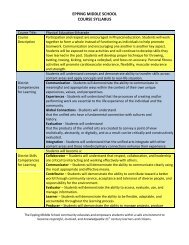Reading Standards for Informational Text & Literature - SAU 14
Reading Standards for Informational Text & Literature - SAU 14
Reading Standards for Informational Text & Literature - SAU 14
Create successful ePaper yourself
Turn your PDF publications into a flip-book with our unique Google optimized e-Paper software.
Grade Two<br />
<strong>Standards</strong><br />
Key Ideas and Details<br />
1. Ask and answer such questions as who, what,<br />
where, when, why, and how to demonstrate<br />
understanding of key details.<br />
2. Identify the main topic of a multi-paragraph<br />
text as well as the focus of specific paragraphs<br />
within the text.<br />
3. Describe the connection between a series of<br />
historical events, scientific ideas or concepts, or<br />
steps in technical procedures in a text.<br />
Craft and Structure<br />
4. Determine the meaning of words and phrases<br />
in a text relevant to a grade 2 topic or subject<br />
area.<br />
5. Know and use various text features (e.g.,<br />
captions, bold print, subheadings, glossaries,<br />
indexes, electronic menus, icons) to locate key<br />
facts or in<strong>for</strong>mation in a text efficiently.<br />
6. Identify the main purpose of a text, including<br />
what the author wants to answer, explain, or<br />
describe.<br />
Integration of Knowledge and Ideas<br />
7. Explain how specific images (e.g., a diagram<br />
showing how a machine works) contribute to<br />
and clarify a text.<br />
8. Describe how reasons support specific points<br />
the author makes in a text.<br />
9. Compare and contrast the most important<br />
points presented by two texts on the same<br />
topic.<br />
Range of <strong>Reading</strong> and Level of <strong>Text</strong> Complexity<br />
10. By the end of year, read and comprehend<br />
in<strong>for</strong>mational texts, including history/social<br />
studies, science, and technical texts, in the<br />
grades 2-3 text complexity band proficiently<br />
with scaffolding as needed at the high end of<br />
the range.<br />
Grade Three<br />
<strong>Standards</strong><br />
Key Ideas and Details<br />
1. Ask and answer questions to demonstrate<br />
understanding of a text, referring explicitly to<br />
the text as the basis <strong>for</strong> the answers.<br />
I can… Statements<br />
I can ask who, what, when, why and how to show I<br />
understand the details of a text.<br />
I can identify the main idea in a text of more than<br />
one paragraph.<br />
I can describe the connection between historical<br />
or scientific ideas or concepts or steps in a<br />
procedure.<br />
I can use text to figure out the meaning of words<br />
I can use text features and search tools to find<br />
in<strong>for</strong>mation that is important to my topic.<br />
I can compare my point of view to the author’s.<br />
I can use in<strong>for</strong>mation from illustrations and text to<br />
show I understand how key events occur.<br />
I can compare or show cause/effect and sequence<br />
in sentences and paragraphs.<br />
I can compare and contrast important points and<br />
details in two texts.<br />
I can use and understand in<strong>for</strong>mational text<br />
independently and proficiently.<br />
I can… Statements<br />
I can ask and answer questions to show I<br />
understand my text and refer back to my text <strong>for</strong><br />
the answer.<br />
<strong>Reading</strong> <strong>Standards</strong> – In<strong>for</strong>mational <strong>Text</strong> and <strong>Literature</strong> Epping School District Page 3 of 16
















